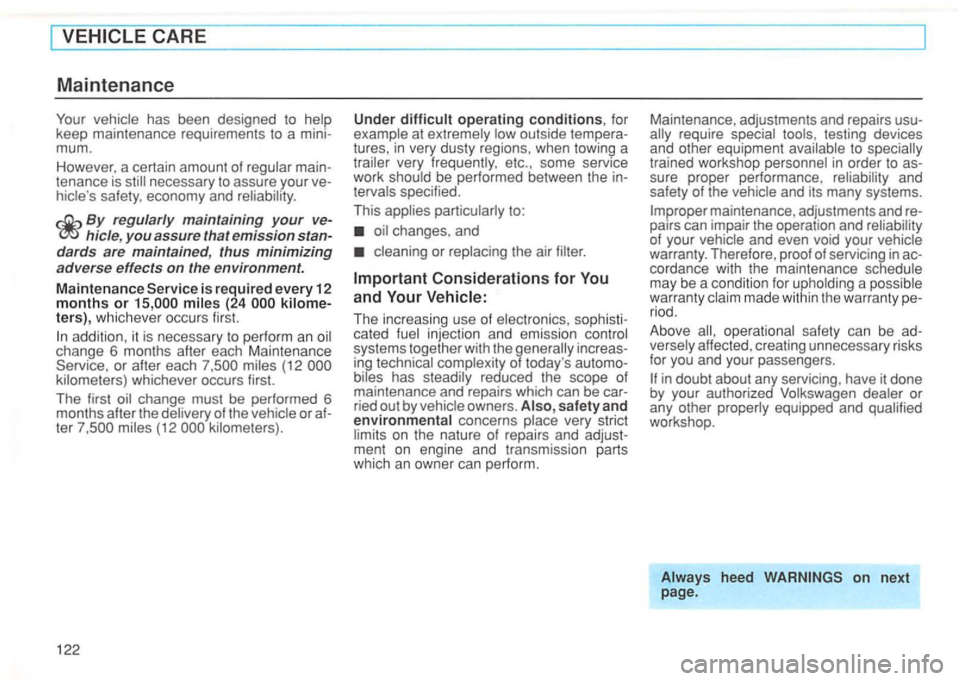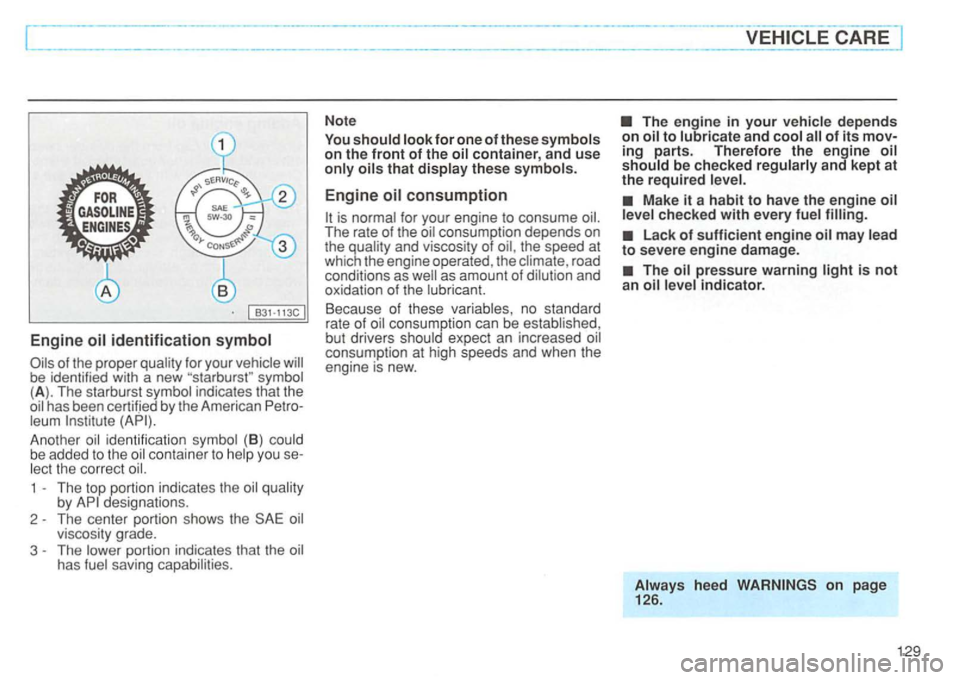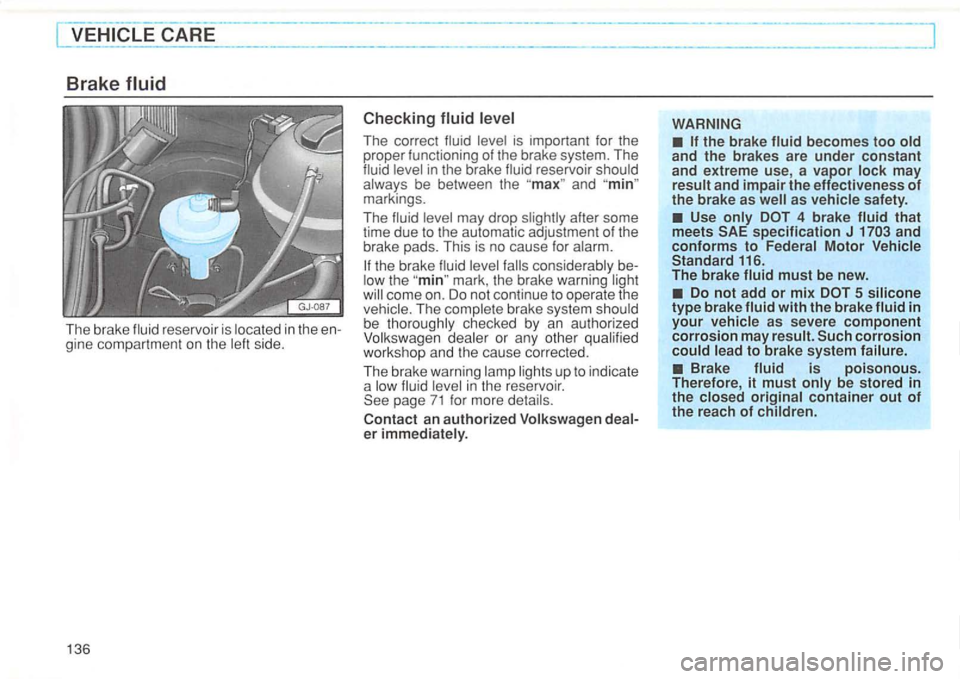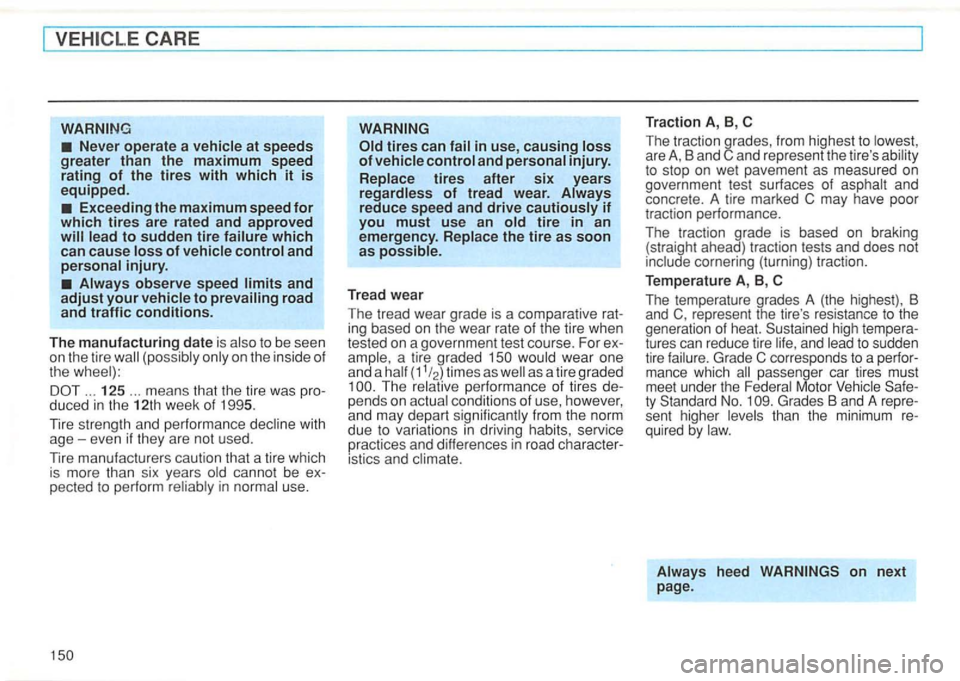Page 110 of 274
Conditions affecting braking
efficiency
Moisture or road salt
WARNING
dry and ice coatings
Driving for an extended period of time on salt-covered roads without using your brakes can also affect
braking efficiency. Clean off accumulated salt coating from brake discs and pads with a few cautious
brake applications. Overheating
the brak es
WARNING
the brakes " by resting your foot on the pedal when you do not intend to brake. This may cause
the brakes to overheat , premature
wear and increased stopping distance .
Before descending a steep grade,
reduce speed and shift transmission into a lower gear or lower driving position. Do not ride the brakes or hold the pedal down too long or too often . This could cause the brakes to get hot and diminish braking
efficiency .
Page 115 of 274
tank
The fue l fille r n eck is loca te d on the right rear
side panel b eh in d th e fuel t an k
open the flap
Note
To open the fuel filler flap via the power locking system, insert the key to the driver's or front passenger's door and turn it twice, see also page 13.
The capacity of the tank is approx . 14.5
soon as the correctly operated nozzle switches off autom atically for the first time , the tank is full. Do not try to
add more fuel, because the expansion space in the fuel tank will be filled-the
fuel can then overflow when it becomes warm and pollutes the environment.
After
vehicles equipped with a catalytic converter, never drive your vehicle until the fuel tank is completely empty. This could cause your engine to misfire and fuel could get into the exhaust system. This could cause the exhaust system to overheat and damage the catalytic converter.
WARNING Never
carry additional fuel containers in your vehicle.
Page 120 of 274
WARNING
Do not use assist fluids".
They may be potentially or cause a
Do not use fuel line antifreeze
offered for gasoline engines
the
that the engine noise penod in winter. is that
ter starting and during warm-up. The
amount of smoke depends on the ou tside
temperature .
Do not off
11 3
Page 129 of 274

vehicle has been designed to help
keep maintenance requirements to a
necessary to ass ure your
By regularly maintaining your hicle, you assure that emission
cha nge 6 months after each Maintenance
Se rvice, or after each miles (12
change must be performed 6
months after the delivery of the
kilometers).
1 22 Und
er difficult operating conditions,
for
example at extremely
tervals specified.
This applies particularly to:
changes, and
The in cr easing use of e lec troni cs , ca ted fuel injection and emission control
s yst ems togethe r wi th the
ing technical complexity of today 's biles has steadily re duced the scope of
maintenance and repairs which can be
ried out by owners. Also, safety and environmental concerns place very strict
l imits on the nature of repairs and
requi re special tools, testing devices
and other equipment available to
trained workshop personnel in order to sure proper performance ,
maintenance , adjustments pairs can impair the operation and of your
operational safety can be versely affecte d, creating unnecessary risks
for you and your passengers .
in doubt about any servicing , have it done
by your author ized Vol kswagen dealer or
any other properly equipped and qualified
workshop.
Always heed WARNINGS on next
page.
Page 136 of 274

B31-113C
Engine oil iden tifica tion symbol
symbol
( A). The starburst symbol indicates that the
oil has been certifjed by the American Petro
leum
Another oil identificatio n symbo l (B ) could be added to th e oil con taine r to help you se
lect the correct oil.
1 The top portion indicate s the oil q uality
by designations.
2
The center portion sh ows the oil
viscosity grade.
3
The lowe r portion indica tes that the oil
has fuel saving capabili ties. No
te
is normal for your engine to consume oil.
The rate of the oil consumption depends on
the quality
and viscosity of oil, the speed at
which the engine operated, the climate, road
conditio ns
as well as amount of dilution an d
oxidatio n of the lubricant.
Beca u
se of these variables, no standard
rate of oil consumption can be established ,
but drivers should expect an increased oil
consum ption at high speeds and when the
engine is
new.
The engine in your vehicle depends
on oil to lubricate and cool all of its ing parts. Therefore the engine oil should be checked regularly and kept at the required level.
Make it a habit to have the engine oil lev el checked with every fuel filling.
Lack of sufficient engine oil may lead
to severe engine damage .
The oil pressure warning
Page 143 of 274

Brake fluid
The brake fluid reservo ir is located in the en
gi ne compa rtment o n th e left side .
136
----------------
Checking
The correct fluid level is importa nt for the
proper functioning of the brake system. The
fluid level
in the brake fluid reservoir should
always be between the and markings.
The fluid level may drop slightly
some
time due to the automatic adjustment of the
brake pads. This is no cause for alarm.
mark , the brake warning light come o n. Do not continue to operate the
v ehicle . The comp le te brake system shou ld
be thoroughly checked by an authoriz ed
Volk sw age n dea l
er or any other qualified
workshop and the cause corr ecte d.
The brake warning lamp lights up
to indicate
a low fluid leve l in the reservoir.
Use only 4 brake fluid that meets SAE specification J and conforms to Federal Motor Vehicle
Standard 116.
The brake
fluid must be new .
Do not add or mix
Brake fluid is poisonous. Therefore , it must only be stored in the closed original container out of the reach of children.
J
Page 157 of 274

CARE
Exceeding the maximum speed for which tires are rated and approved
Always observe speed limits and adjust your vehicle to prevailing road and traffic conditions.
The manufacturing date is also to be seen on the tire wall (poss ibly only on the inside of
t h e wheel):
WARNING
ing based on the wear rate of the tire when
tested on a government test course. Fo r
T he relat ive performance of tires pends on actual conditions of use, however ,
and may depart significantly fr om the norm
due to variat ions in driving habits , service
p ractices and differences in road
The tr act ion grades , fr om highest to lowest ,
are A, B and C and represent the tire 's ability
t o s top on wet pavement as measured on
gove
rnment test surfaces of asphal t and
concrete . A tire marked C may have poor
tract ion perfo rmance.
The traction grade is based
on braking
( straight ahead) tract ion tests and does not
include cornering (turn ing) traction.
Temperatur e A, B ,
The temperature grades A (the highest), B
and C, represent the tire's resistance to the
gene ration of heat. Sustained high
ty Standard No. 1
quired by law.
Always heed on next
p age .
Page 166 of 274
Changing a wheel
you have a
on and use other warning devices to other motorists.
Passengers must not remain in the
away from the and away from the roadway and
traffic.
Before you change a be sure the ground is
After make sure that you remount the tire in its storage area and tighten the nut
To from moving set the parking brake and
being changed. When one front is
transmission not prevent movement.
YOURSELF
Remove the
Remove the center cover using the wrench and the hub cap of your hub cap , the
wrench through the and pry the
cover off. have
covers which you can pry off using the
Page:
< prev 1-8 9-16 17-24